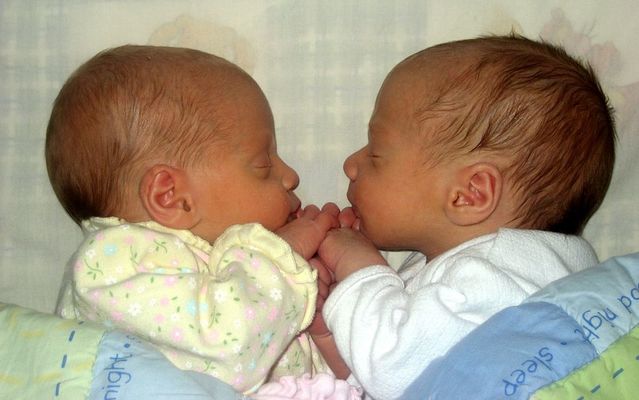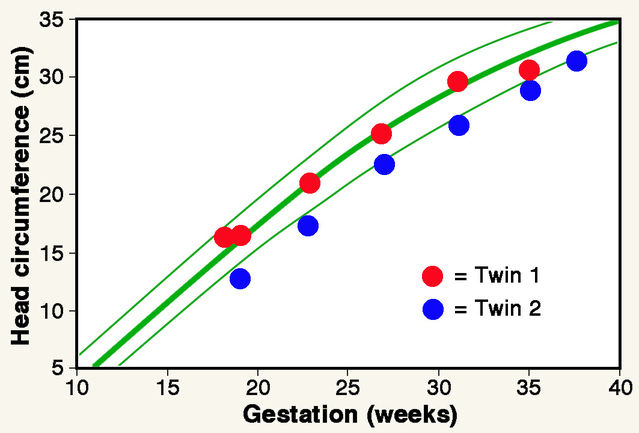Understanding Twins
Twins With Two Daddies
Strange cases of split paternity raise questions about human conception.
Posted June 22, 2017 Reviewed by Lybi Ma

Twins occur in about one out of 90 human pregnancies in the US. As a rule, at conception, one sperm fertilizes a single egg to produce a zygote. Two thirds of twins are fraternal, with fertilization of two separate eggs yielding a pair of zygotes (dizygotic twins). The remaining third arise when a single zygote splits to give two genetically identical embryos (monozygotic twins). The difference between fraternal and identical twins is common knowledge. But it is far less widely known that fraternal twins occasionally have different fathers (spilt paternity). This is immediately obvious only when twins differ strikingly in appearance, notably in skin colour. However, DNA testing is now revealing split paternity even when twins look quite similar.

Reports of Split Paternity
Cases of twins with different fathers have been reported only rarely, mostly as an outcome of paternity suits. Beginning in the 1920s, early genetic testing depended on rather weak indicators from basic blood typing. But things improved considerably in the 1960s, when it became possible to use highly variable genetic markers connected with proteins that play a key role in the immune system. In 1978, Paul Terasaki and colleagues reported a case in which such markers yielded convincing evidence that fraternal twins had been fathered by two different men. They calculated a probability of 96.8 percent that the first man fathered Twin 1 and a probability of 99.9 percent that the second fathered Twin 2. Terasaki and colleagues laconically noted: "When made aware of these facts, the mother said that she had suspected such a possibility…"

Eventually, in the 1980s, the advent of DNA typing ushered in highly reliable paternity testing. In one striking example, in 2015 a New Jersey judge ruled that a man needed to pay child support for only one twin because DNA evidence revealed that he was not in fact the father of the other. The twins’ mother admitted in court that she'd had sexual intercourse with a second man close to the time of conception. In a more recent case, reported from Vietnam in 2016, parents took their fraternal twin boys to an institute for genetic testing because relatives had repeatedly commented on marked physical differences between them. One had thick, curly hair, while the other’s was thin and straight. The family suspected that some mix-up might have occurred at the hospital, but DNA testing confirmed that the woman concerned was the mother of both twins. The tests also revealed that the twins had different fathers.
Split paternity is not confined to humans. DNA evidence has also permitted identification of twins with two different fathers in non-human primates that usually have single births. In 2002, Fred Bercovitch and colleagues reported finding one pair of twins with different fathers while investigating paternity in 1,500 free-ranging Rhesus macaques in the famous colony on the island of Cayo Santiago off the coast of Puerto Rico. Subsequently, in 2006, John Ely and colleagues noted identification of one case of split paternity in chimpanzees, in a study of 44 sets of fraternal twins. It therefore seems that shared paternity in chimpanzees may be distinctly more common than in humans.
Separate conceptions
Given the expectation that two fertile acts of coitus with different men are likely to be separated in time, however, we need to ask how two conceptions can occur. Although a human egg can survive no longer than 24 hours after ovulation, it is now generally accepted that sperms can survive for at least five days after ejaculation and perhaps even 10 days or more in the human womb. (See my blog post "What Dogs Can Tell Us About Sex and Conception.") It is therefore theoretically possible that split paternity could arise from two virtually simultaneous ovulations despite an interval of several days between acts of coitus with two different men. However, it is also possible that a woman may ovulate on two separate occasions in a single menstrual cycle, such that two conceptions could result from direct fertilization of eggs by different men several days apart, without intervening sperm storage.

It is often assumed that the two separate conceptions in cases of split paternity must occur within a single menstrual cycle. The technical term superfecundation is used for this, expanded to heteropaternal superfecundation when two different men father fraternal twins. However, it is also possible — at least in theory — that separate conceptions leading to twins might occur in separate cycles, in which case the term superfetation should be used instead. Because two conceptions in successive cycles will be about four weeks apart, one twin will clearly lag behind the other (discordant development). A disparity of this kind can be detected by regularly monitoring fetal development using ultrasound, as G.D. Tuppen and colleagues elegantly showed in a 1999 report on a twin pregnancy in a 38-year-old woman. A marked disparity in size, corresponding to a 4-week difference in gestation time between the fetuses, was identified during the first trimester and persisted throughout the pregnancy. Spontaneous, uncomplicated labor led to live birth of a girl weighing 7.2 pounds and boy weighing 5.1 pounds at gestational ages of 40 and 36 weeks, respectively.

Dating back to Aristotle, the classical example for superfetation — the simultaneous occurrence of different developmental stages in a single pregnancy — is the European brown hare. Doubtless because this phenomenon is so unusual, superfetation in hares has repeatedly been questioned. However, recent experiments conducted by Kathleen Roellig and colleagues using high-resolution ultrasonography have confirmed that female hares do indeed often show additional ovulations while already pregnant. Flushing of oviducts revealed the presence of early embryonic stages in addition to fully developed fetuses in the womb, and the occurrence of later conceptions was confirmed by paternity analysis using genetic markers. Seemingly, hares can produce a third more offspring per breeding season in this way.
Convincing evidence for superfetation has also been reported for the American mink and the European badger.
Wider implications
Unless infidelity is suspected, the possibility of split paternity is unlikely to be considered in paternity suits involving fraternal twins unless they differ distinctly in physical appearance. Accordingly, the frequency of superfecundation and/or superfetation is doubtless markedly greater than indicated by the 20 or so reports that have become public knowledge. But there are even wider implications that have rarely been mentioned when it comes to the possibility that fraternal twins might result from two separate conceptions involving a single male partner. As paternity is not shared with another man in such cases, DNA tests are of no value. Regular monitoring with ultrasonography could yield convincing evidence in cases of conception in two successive cycles (superfetation), but is unlikely to do so if two separate conceptions occur just days apart in the same cycle (superfecundation). Overall, it is quite possible that fraternal twins may arise from conception on two clearly separate occasions in a substantial proportion of cases.
In a 1993 paper, William (Bill) James published population-wide estimates of the frequencies of superfecundation and split paternity with fraternal twins. He calculated that superfecundation (fertilization of two eggs by sperms from different acts of coitus) occurs in at least one in 12 fraternal twin pregnancies. He also inferred that split paternity occurs in about one in 400 pairs of fraternal twins born to married white women in the USA. Interestingly, these two estimates taken together yield the conclusion that only 3% of fraternal twin pairs conceived by married women in separate acts of coitus result from split paternity. This provides further evidence that rampant speculation about frequent direct sperm competition in human conception (“sperm wars”) is unwarranted.
References
Bercovitch, F.B., Widdig, A., Berard, J.D., Nuernberg, P., Kessler, M.J., Schmidtke, J., Trefilov, A. & Krawczak, M. (2002) Multiple sirehood in free-ranging twin rhesus macaques (Macaca mulatta). American Journal of Primatology 57:31-34.
Bever, L (2016) How these twins turned out to have different fathers. Washington Post https://www.washingtonpost.com/news/to-your-health/wp/2016/03/10/dna-sh…
Cassimally, K.A. (2011, April 27) Superfetation: Pregnant while already pregnant. Scientific American https://blogs.scientificamerican.com/guest-blog/superfetation-pregnant-…
Ely, J.J., Frels, W.I., Howell, S., Izard, M.K., Keeling, M.E. & Lee, D.R. (2006) Twinning and heteropaternity in chimpanzees (Pan troglodytes). American Journal of Physical Anthropology 130:96-102.
Geada, H., Ribeiro, T., Brito, R.M., Espinheira, R., Rolf, B., Hohoff, C. & Brinkmann, B. (2001) A STR mutation in a heteropaternal twin case. Forensic Science International 123:239-242.
James, W.H. (1993) The incidence of superfecundation and of double paternity in the general population. Acta Geneticae Medicae et Gemellologiae 42:257-262.
McNamara, M.C., Kane, S.C., Craig, J.M., Short, R.V. & Umstad, M.P. (2015) A review of the mechanisms and evidence for typical and atypical twinning. American Journal of Obstetrics & Gynecology 214:172-191.
Roellig, K., Goeritz, F., Fickel, J., Hermes, R., Hofer, H. & Hilderbrandt, T.B. (2010) Superfetation in mammalian pregnancy can be detected and increases reproductive output per breeding season. Nature Communications 1,78:1-7.
Roellig, K., Menzies, B.R., Hildebrandt, T.B. & Goeritz, F. (2011) The concept of superfetation: a critical review on a “myth” in mammalian reproduction. Biological Reviews 86:77-95.
Soudre, G., Guettier, X., Marpeau, L., Larue, L., Jault, T. & Barrat, J. (1992) In utero early suspicion of superfetation by ultrasound examination: a case report. Ultrasound in Obstetrics & Gynecology 2:51-54.
Terasaki, P.I., Gjertson, D., Bernoco, D., Perdue, S., Mickey, M.R. & Bond, J. (1978) Twins with two different fathers identified by HLA. New England Journal of Medicine 209:590-592.
Tuppen, G.D., Fairs, C., de Chazal, R.C. & Konje, J.C. (1999) Spontaneous superfetation diagnosed in the first trimester with successful outcome. Ultrasound in Obstetrics & Gynecology 14:219-221.


